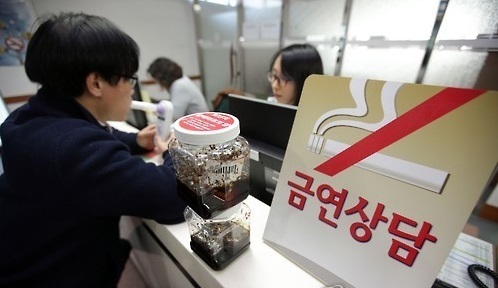Low income individuals are more likely to smoke than those who are considered wealthy, a study conducted by Seoul National University Hospital showed Monday.
The study, conducted by professor Kang Young-ho, looked at 1.59 million people between 2008 and 2014. It looked at both genders in 245 counties and cities.
The study, conducted by professor Kang Young-ho, looked at 1.59 million people between 2008 and 2014. It looked at both genders in 245 counties and cities.

Male smokers in 236 of the 245 locations followed the overall correlation between smoking and income levels. Female smokers’ income levels corresponded to the findings in 239 of the locations.
In all 245 places, the smoking rate among the bottom 20 percent of the income pyramid was higher than the top 20 percent.
Bundang-gu, Seongnam, Gyeonggi Province, had the lowest smoking rate among male residents in the upper 20 percent income bracket with 26.4 percent, while Taebaek, Gangwon Province, had the highest smoking rate in the lower 20 percent, with 59.8 percent.
The figure is considerably higher than the average smoking rate of 39.3 percent for males aged over 19, reported by the Ministry of Health and Welfare in 2015.
Women categorized as high earners in Jangseong County, South Jeolla Province, had the lowest smoking rate among women, with 0.2 percent, and Dongducheon, Gyeonggi Province, had the highest rate at 13 percent.
The largest differences in smoking rates among the income groups were observed in Uljin, North Gyeongsang Province, for males, with a 20.2 percentage point difference, and Dongducheon, Gyeonggi Province for females, with a 9.5 percentage point difference.
In Seoul the inequality was most visible in districts such as Yongsan, Mapo, Gwangjin and Dongdaemun.
According to the team that conducted the research, South Korea’s smoking trends are starting to catch-up with those of higher income nations, where people at the bottom of the income pyramid are more often associated with heavy smoking.
“Despite the team’s achievements on recognizing the widening inequality gap through smoking rates, further research is necessary to measure the variation in the future trend,” said Kang.
By Jung Min-kyung mkjung@heraldcorp.com)







![[KH Explains] How should Korea adjust its trade defenses against Chinese EVs?](http://res.heraldm.com/phpwas/restmb_idxmake.php?idx=644&simg=/content/image/2024/04/15/20240415050562_0.jpg&u=20240415144419)











![[Today’s K-pop] Stray Kids to return soon: report](http://res.heraldm.com/phpwas/restmb_idxmake.php?idx=642&simg=/content/image/2024/04/16/20240416050713_0.jpg&u=)